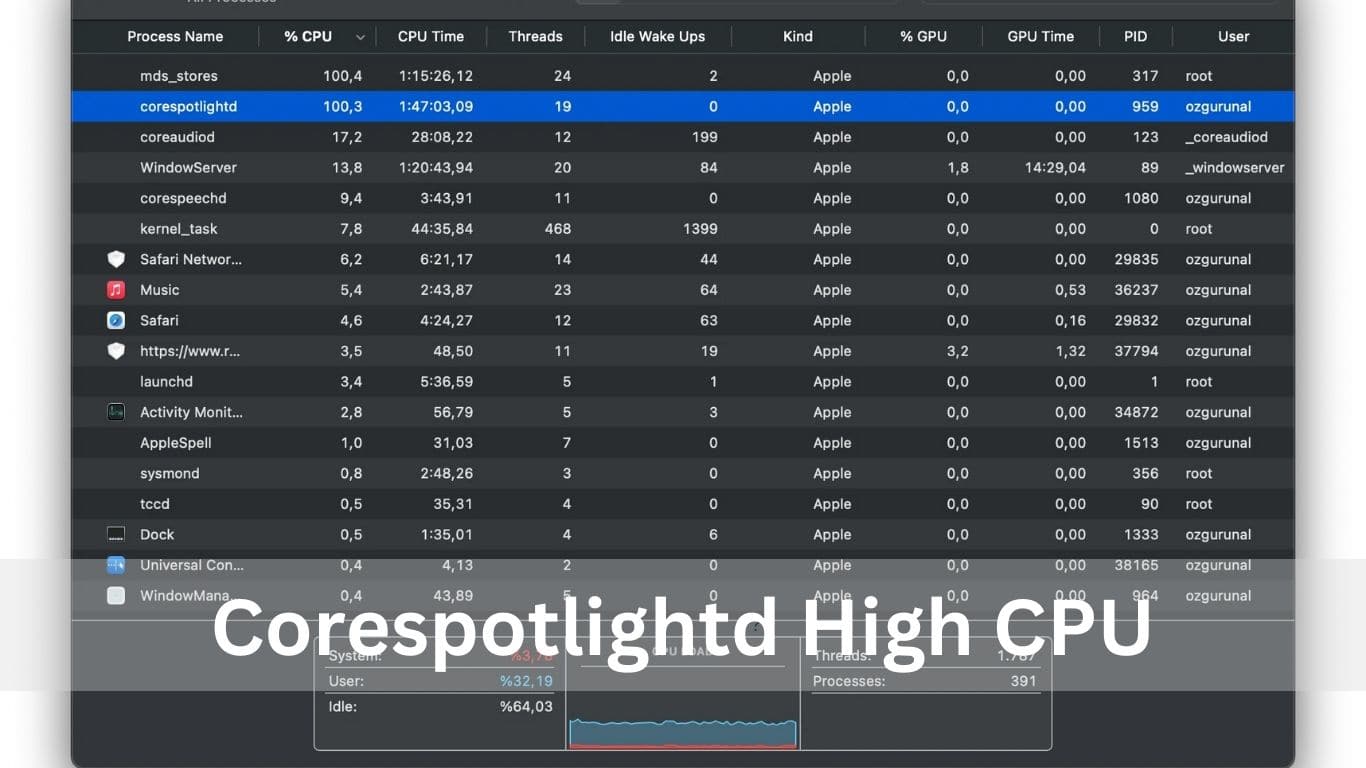I once had my Mac slow down because Corespotlightd used too much CPU. It frustrated me, but I found simple fixes to speed things up again. Let me share them.
Corespotlightd High CPU (short answer)
Yes, Corespotlightd High CPU usage happens when your Mac is indexing files for faster searches. To fix it, try restarting your Mac, reindexing Spotlight, or updating macOS for smoother performance.
In this article, we will discuss Corespotlightd High CPU.
Understanding High CPU Usage
High CPU usage means your computer is working hard, slowing its performance. It happens when programs or processes use a lot of power. Fixing it prevents overheating and keeps your system running smoothly.
What Is Corespotlightd On Mac?
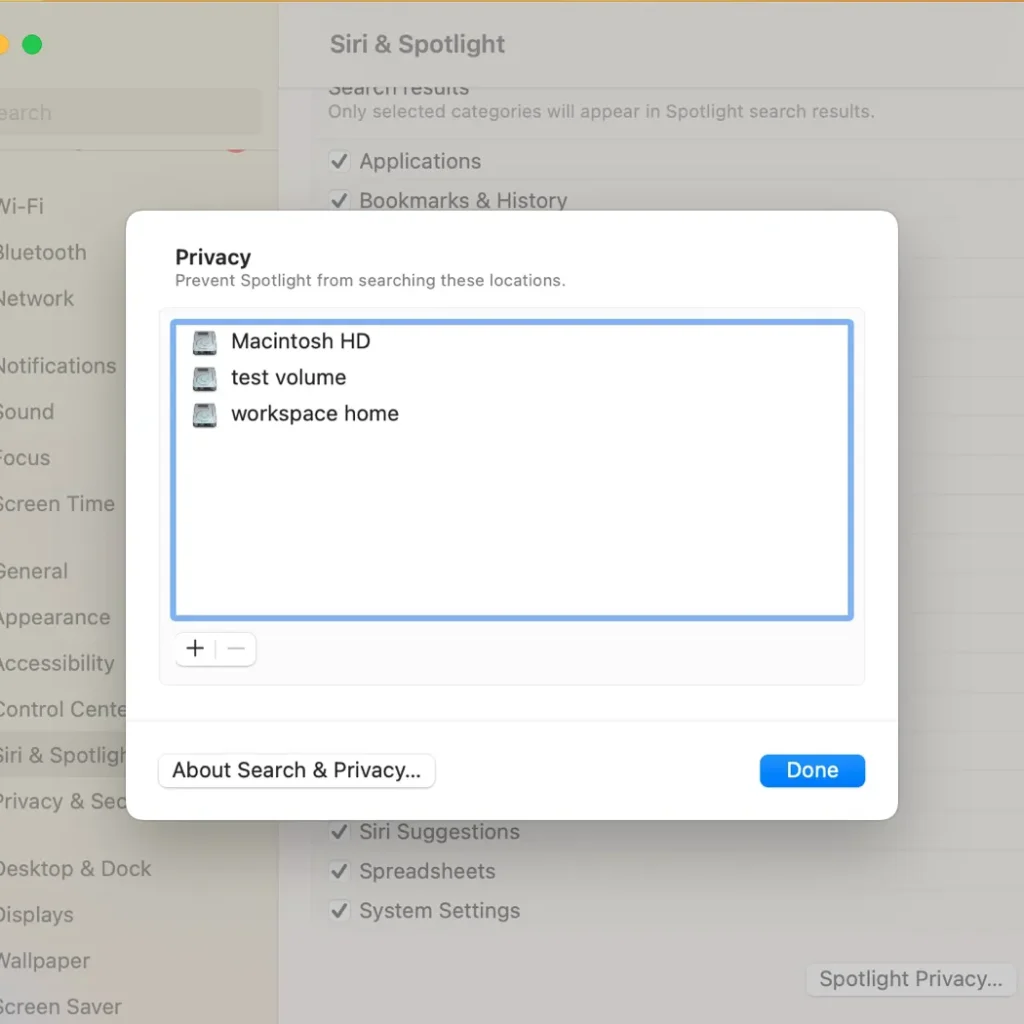
Corespotlightd on Mac is a background process that helps speed up file and app searches. It constantly indexes data, ensuring fast results when using Spotlight or Finder for quick access to content.
What Is Corespotlightd?
Corespotlightd is a macOS system process that helps speed up searches by indexing and organizing files, apps, and emails. It ensures fast search results but can sometimes cause high CPU usage during intensive indexing.
What Is Corespotlightd Mac?
Corespotlightd on a Mac is a system service that helps index files and apps, ensuring fast and accurate search results in Spotlight and Finder. It improves the efficiency of locating documents and other data.
What Is Spotlight Knowledged?
Spotlightknowledged is a macOS process that assists Spotlight in indexing and managing search data. It runs in the background to enhance search speed and accuracy, helping you quickly find files and information on your Mac.
Corespotlightd High CPU Mac
When Corespotlightd consumes a lot of CPU on a Mac, it usually means it’s heavily indexing files. This can slow down your system, causing a laggy experience when using your Mac.
Corespotlightd: CPU Usage Super High
When Corespotlightd uses too much CPU, it’s busy indexing files, which can slow down your Mac. This happens because the process takes up a lot of your computer’s power, affecting its overall speed and performance during searches.
Read Also: Does Amd Gpu Work With Intel Cpu? A Comprehensive Overview!
What Is Process Corespotlightd?
The corespotlightd process is an essential component of macOS that manages the search index. It indexes files, emails, and apps on your Mac, making searches quick and accurate, so users can easily find what they need.
Why Does Corespotlightd Cause High CPU Usage?
Corespotlightd causes high CPU usage mainly when it indexes many files, especially after adding or changing them. If there are corrupted files or conflicts with other apps, it can further overload the CPU, slowing down performance.
1. Scenarios:
Corespotlightd’s CPU usage spikes in these scenarios:
- When large external drives are connected, triggering spotlight indexing.
- Frequent reindexing happens if many files are added or modified quickly.
- Corrupted files or errors cause repeated indexing attempts, straining the system.
If high CPU usage continues, it may indicate deeper issues that need fixing.
How To Fix Corespotlightd High CPU Usage?
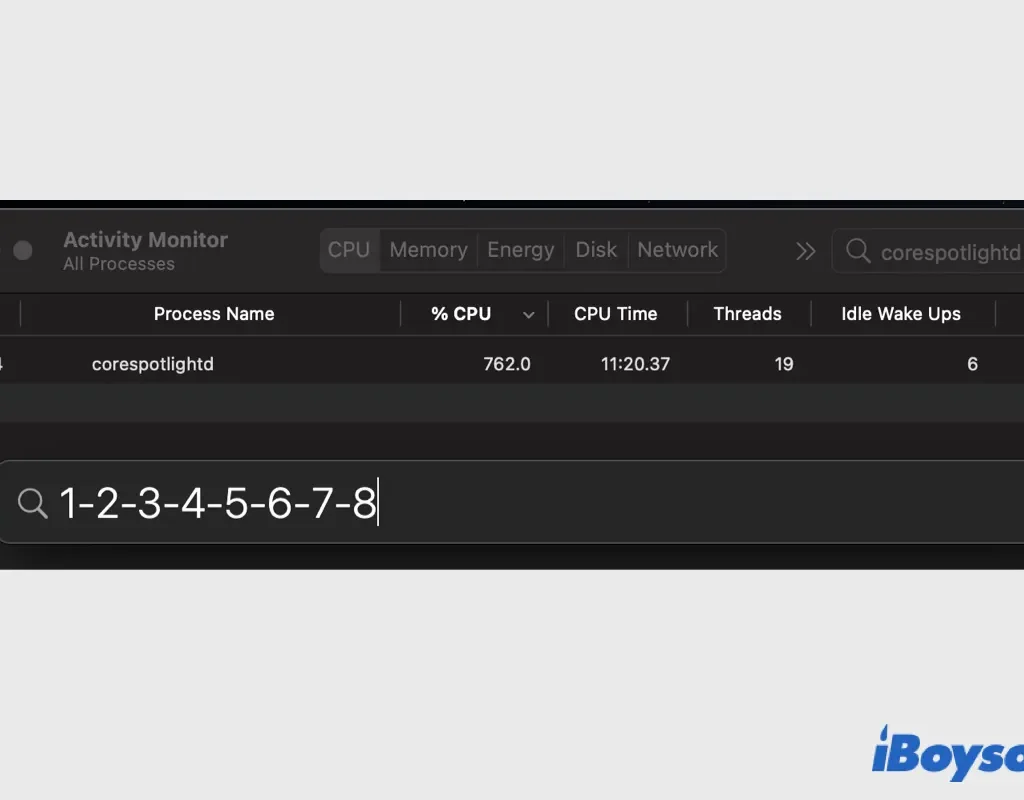
1. Kill the Corespotlightd Process
To stop the corespotlightd process, open Activity Monitor on your Mac. Find corespotlightd in the list, select it, and click the X button to quit it. This can help free up CPU and fix high usage issues.
2. Restart Your Mac
Restarting your Mac may resolve high CPU usage by refreshing system processes. Just go to the Apple menu and choose Restart. This simple action can help clear temporary issues and enhance performance.
3. Reindex Your Disks
Reindexing your disks can help solve corespotlightd high CPU problems. Go to System Preferences, open Spotlight, then select the Privacy tab. Add and remove your disks from the list to force Spotlight to reindex your files.
4. Update macOS
Updating macOS can help fix bugs and boost performance. To do this, go to System Preferences and click on Software Update. Keeping your Mac updated ensures you get the latest features and fixes, which may resolve high CPU usage issues.
5. Clean Reinstall macOS
A clean reinstall of macOS can fix ongoing issues by restoring your system. First, back up your data. Then, use Recovery Mode to reinstall macOS. This fresh start can resolve software conflicts causing high CPU usage.
What Can You Do When The CPU Consumes A Lot Of Resources?
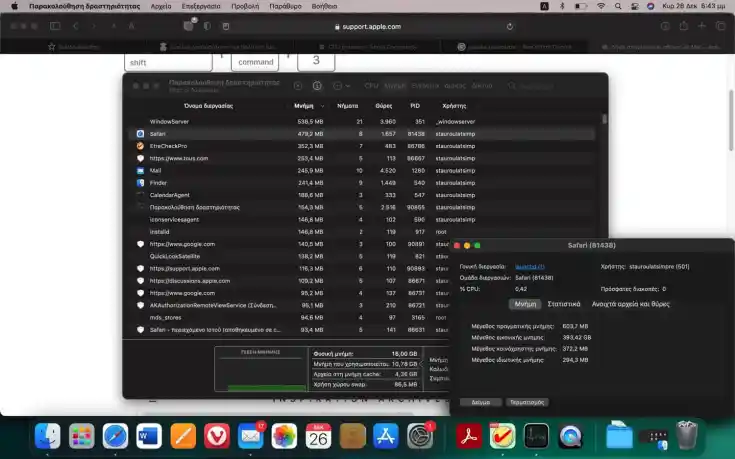
1. Restart Mac:
Restarting your Mac can help fix performance issues, including high CPU usage from corespotlightd. Just click the Apple menu and select Restart to refresh your system and improve performance.
2. Kill Corespotlightd In Activity Monitor:
To reduce high CPU usage caused by corespotlightd, open Activity Monitor, locate corespotlightd in the list, and click the X button to force it to quit. This can help improve your system’s overall performance.
3. Removing Some Data From Indexing:
To fix high CPU usage from Corespotlightd, go to Spotlight preferences. Add your disks, then remove them. This action forces a reindex, helping refresh the indexing process and potentially reducing CPU usage.
Read Also: CPU Core Ratio Sync All Cores Or Auto – Ultimate Guide 2024!
How to Diagnose Corespotlightd Cpu Issues?
1. Monitoring with Activity Monitor:
To monitor your system’s performance, open Activity Monitor and click on the CPU tab. Here, you can check if Corespotlightd is using a lot of CPU power. Constant high usage suggests there’s an issue that needs fixing.
2. Identifying abnormal usage:
Abnormal usage happens when your Mac feels slow, and Corespotlightd uses a lot of CPU for a long time. If the fan is loud or your Mac is hot without heavy tasks, it could mean Corespotlightd is working too hard.
Solutions To Reduce Corespotlightd High CPU Usage:
1. Optimizing spotlight indexing:
To optimise Spotlight indexing, exclude folders you don’t often search. This lightens the workload for Corespotlightd. Simply go to System Preferences, choose Spotlight, and add those folders to the Privacy list to prevent indexing.
2. Clearing and Rebuilding Indexes:
To clear and rebuild Spotlight indexes, go to Spotlight preferences and add your hard drive to the Privacy list. Then, remove it. This action forces Spotlight to rebuild its index, helping resolve Corespotlightd CPU usage issues.
3. Managing Large Files and External Drives:
To manage Corespotlightd’s CPU usage, remove or archive large files, and limit indexing on external drives. This helps reduce workload and prevents high CPU usage when these drives are connected, improving overall system performance.
Read Also: Is 4000 RPM Too Low For A CPU Fan? Detailed Guide!
Preventing Future Corespotlightd Cpu Spikes:
1. Regular System Maintenance:
Regular system maintenance, like clearing the cache and deleting old files, keeps your Mac organized. This helps Corespotlightd run smoothly and prevents high CPU usage, ensuring your computer remains fast and efficient.
2. Staying Updated:
Always keep your macOS and apps updated. Updates usually fix bugs and improve performance, which can help reduce CPU issues with Corespotlightd. Staying current ensures your Mac runs smoothly and efficiently.
3. Monitoring System Performance:
Regularly check your Mac’s performance with Activity Monitor. This tool helps you notice early signs of high CPU usage by Corespotlightd. If you detect problems, you can take action before they worsen.
Deeper Analysis of Corespotlightd High CPU Usage:
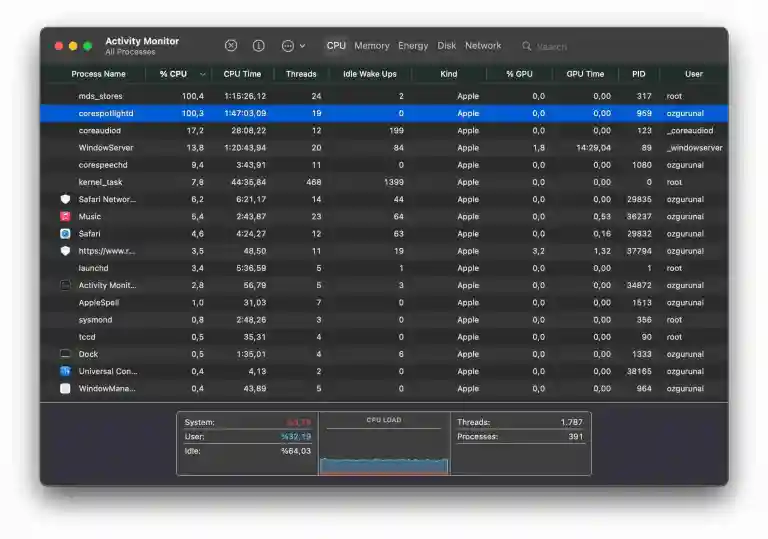
1. Use Activity Monitor:
To check if corespotlightd is using too much CPU, open Activity Monitor and search for it. This helps you see its CPU usage and decide if it needs attention.
2. Check Disk health:
To keep your Mac running well, use Disk Utility to check your disk for errors. A healthy disk helps prevent problems with corespotlightd and high CPU usage, ensuring smooth performance.
3. Review Console Logs:
To troubleshoot corespotlightd issues, check the Console app for error messages. Reviewing the logs can help identify why corespotlightd is using a lot of CPU and guide you in fixing the problem.
4. Reset spotlight preferences:
To fix high CPU use by corespotlightd, reset spotlight settings to the default in System Preferences. This can help restore normal indexing and reduce CPU usage problems.
5. Consider third-party alternatives:
To lower CPU usage from corespotlightd, try using other search apps instead of Spotlight. This can help reduce the load on your system and improve performance.
6. Check for Third-Party App Interference:
Look at the apps you have installed to see if any are making corespotlightd use a lot of CPU. Uninstalling or updating these apps can help fix the problem.
7. Review System Logs:
Open the Console app to review system logs for issues causing high CPU usage by corespotlightd. This can help you pinpoint problems that may need attention and fixes.
8. Apple Support and Community Forums:
Visit Apple Support or community forums for assistance with corespotlightd’s high CPU usage. You can find helpful tips, solutions, and expert advice from other users to resolve your issues effectively.
Read Also: CPU Machine Check Architecture Error Dump – Fixed 100% in 2024
Force Quit Corespotlightd Process
To force quit corespotlightd and reduce high CPU usage, open Activity Monitor. Locate corespotlightd, click the “X” icon, and confirm to stop the process. This action can help improve your Mac’s performance.
Identifying Corespotlightd High CPU Usage
- Check Activity Monitor: Open Activity Monitor, find corespotlightd, and check its CPU usage percentage.
- Watch CPU Percentage: High CPU percentages indicate that corespotlightd is using a lot of resources.
- Look for Consistent Usage: If corespotlightd uses a high CPU continuously, it may slow down your system.
- Notice System Slowdowns: Pay attention to any lags or slowdowns when corespotlightd is using a high CPU.
- Observe Indexing Activity: Check if corespotlightd is indexing files, as this can temporarily increase CPU usage.
- Monitor Over Time: Track the CPU usage patterns of corespotlightd to see if spikes are consistent or occasional.
Causes of Corespotlightd High CPU Usage
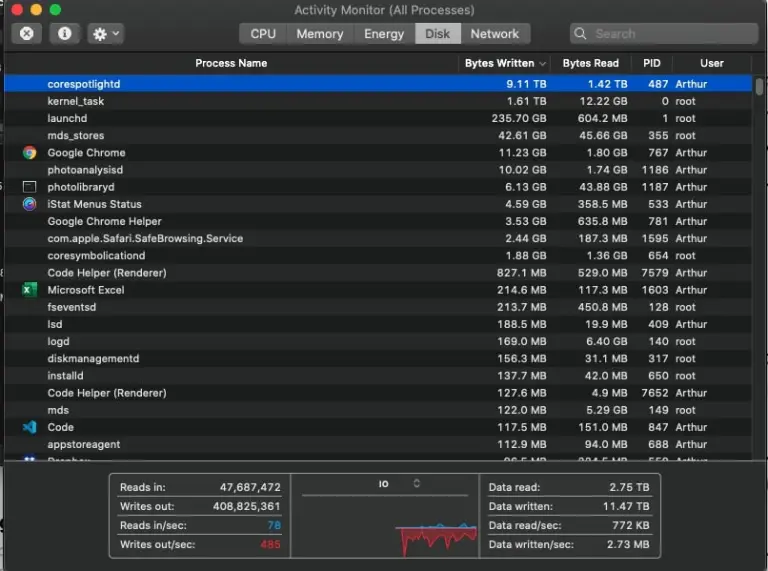
- Large File Indexing: Corespotlightd can consume significant CPU resources when it indexes large files or entire folders.
- File System Errors: Errors within the file system may lead corespotlightd to repeatedly index files, resulting in increased CPU usage.
- Corrupted Spotlight Index: A damaged indexing database can cause corespotlightd to excessively reindex files, leading to high CPU demands.
- Third-Party Apps: Some applications that interact with the file system can trigger corespotlightd to use more CPU resources.
- External Drives: Connecting external drives or network volumes can raise corespotlightd’s CPU usage as it indexes new content.
- Software Updates: After updates to macOS, corespotlightd might need to reindex files, which can temporarily increase CPU usage.
- Search Activity: Frequent or complex searches using Spotlight can lead to elevated CPU usage by corespotlightd.
- File System Changes: Modifications to the file structure or frequent changes to files can prompt corespotlightd to update its indexes more often.
- Hardware Issues: Problems with storage devices or insufficient system resources can force corespotlightd to work harder, increasing CPU consumption.
- Spotlight Preferences: Customized settings in Spotlight can affect how corespotlightd operates and impacts its CPU usage during indexing.
When To Seek Professional Help For Corespotlightd Issues:
If corespotlightd still uses too much CPU after you’ve tried fixing it, ask for help. Contact a professional or Apple Support if your Mac remains slow or gets too hot.
1. Apple Support and Other Resources:
Apple Support offers expert help for corespotlightd problems. You can contact them online or visit a store. For additional support, check Apple’s forums or seek advice from reliable macOS troubleshooting experts.
Disable Google Drive or Dropbox
If corespotlightd is using a lot of CPU, try turning off Google Drive or Dropbox syncing for a while. Syncing large files can overload Spotlight indexing and lead to high CPU usage.
Alternative Search Options
If corespotlightd uses too much CPU, try using Finder’s search feature or other third-party apps. They can help you find files without slowing down your Mac.
Corespotlightd And Mis_stores High CPU Usage Error
The Mis Stores folder can make corespotlightd use too much CPU. To fix this, delete the Mis Stores folder or reindex Spotlight. This will clear any corrupted data and improve your Mac’s performance.
Corespotlightd Ask A Lot Of CPU
Corespotlightd might use a lot of CPU because it indexes files or because of software bugs. You can fix this by reindexing Spotlight, updating macOS, or getting help from Apple Support.
Corespotlightd High CPU Sonoma
On Macs with the Sonoma version of macOS, corespotlightd may use a lot of CPU. This usually occurs during indexing tasks or when interacting with other software.
Read Also: CPU How Hot Is Too Hot – A Detailed Overview!
Core Spotlight Uses High CPU When Running Evernote
When Evernote is open, Core Spotlight may use more CPU because it indexes Evernote’s content for quick searches. If you see high CPU usage, it’s probably due to this indexing activity.
Corespotlightd Using Significant CPU In 11.2.2 (20d80)
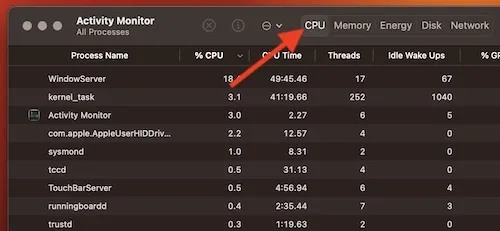
Users with macOS version 11.2.2 (20D80) might notice that corespotlightd uses a lot of CPU. This usually happens during background indexing tasks or when the system refreshes its database.
Corespotlightd Constant CPU Drain In Macos Monterey 12.6 (21 GB)
In macOS Monterey 12.6 (21G115), corespotlightd can continuously use CPU resources, impacting overall system performance. To resolve this, check for indexing errors or simply reboot your Mac to reset the processes.
Macos Ventura Powerful Activity Utilising Over 100% CPU
In macOS Ventura, some users may experience the power process using over 100% CPU, affecting system responsiveness. To address this issue, it’s important to troubleshoot and find the root cause of the high usage.
Macos: Heavy Disk Written and Read By Corespotlightd, How To Fix?
If corespotlightd is heavily reading from or writing to your disk, it can slow down your Mac. To fix this, try reindexing your files or using macOS tools to check for disc errors.
Why Would Spotlight Be Using Lots Of CPU When Only A Few Things Are Being Indexed?
Spotlight can use a lot of CPU, even if it’s only indexing a few files because it might be updating its database or running background processes. This helps keep search results accurate and up-to-date.
Spotlight Consumes 100% CPU On All Cores After Every Single Spotlight Search
Spotlight may use 100% of all CPU cores after every search because it’s working to process the query and update its database with the latest changes. This can happen as part of its normal function.
Why Corespotlightd uses high-resource Resources CPU?
Corespotlightd uses a lot of CPU because it indexes files to keep Spotlight running efficiently. This indexing helps ensure that files are easy to find when you search for them.
High CPU Usage By Xpcproxy
High CPU usage by xpcproxy usually means that background processes or system services are using too many resources. Finding and fixing these issues can improve your Mac’s overall performance.
Corespotlightd High CPU Usage
Corespotlightd can use a lot of CPU, which may slow down your Mac. This usually happens during file indexing. Restarting your Mac or reindexing your disks can help resolve the problem.
Corespotlightd High CPU Ventura
In macOS Ventura, corespotlightd can consume a lot of CPU, which may slow down your system. Restarting your Mac or checking for indexing errors can help fix this issue.
Window server Mac High CPU
WindowServer on a Mac may use a lot of CPU, leading to slow performance and overheating. You can reduce CPU usage by minimizing visual effects or checking for problematic applications.
Photolibraryd High Cpu
If photolibraryd is using a lot of CPU, it can slow down your Mac, especially during photo syncing or backup. Updating macOS or optimizing your photo library can help boost performance.
Corespotlightd is taking 94-99% CPU.
If corespotlightd is using 94-99% of the CPU, your Mac may become slow. Restarting or reindexing files can help resolve this problem and enhance overall system performance.
Imagent – Eating Memory and CPU Usage
If IMAGENT is consuming a lot of memory and CPU, it can slow down your Mac. Restarting your device or updating the software may help resolve this issue and enhance performance.
Spotlight Taking 150% CPU
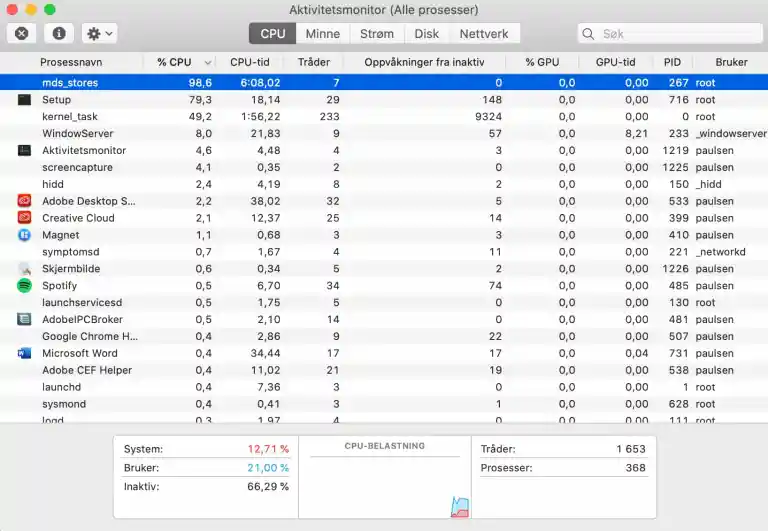
If Spotlight is using 150% CPU, it can make your Mac slow. This usually occurs during indexing or search activities. Restarting your Mac or reindexing files can help improve performance.
Mysteriously Slow Imac
If your iMac is running slowly for no clear reason, it could be caused by high CPU usage from background processes like indexing. Using Activity Monitor to check for issues or restarting your Mac can help improve performance.
Sonoma 14.4 Kernel_task CPU Usage Extremely High
In macOS Sonoma 14.4, if Kernel_Task is using too much CPU, it can slow down your Mac. Restarting or updating macOS may help fix this issue and improve overall performance.
Safari Keeps Crashing On My Macbook With Macos Sonoma.
If Safari keeps crashing on your MacBook with macOS Sonoma, it may be because of high CPU usage. Try updating Safari or restarting your MacBook to improve stability.
Corespotlight Service High Ram Usage
CoreSpotlight can use a lot of RAM when indexing or handling large data sets. This often occurs during searches. You can reduce high memory usage by optimizing Spotlight settings in your Mac’s preferences.
Spotlight Causing High CPU Usage
Spotlight may consume a lot of CPU when indexing large files or external drives. To reduce CPU usage and enhance your Mac’s performance, you can optimize indexing settings or clear Spotlight’s index.
Corespotlightd: Writing Data Faster Than I Can Delete It!
If Corespotlightd is writing data faster than you can delete it, it may be due to heavy indexing. To manage this, consider excluding large folders from Spotlight indexing or rebuilding the Spotlight index.
Ridiculously High Disk Write Rate From Unknown Processes – 26 TB In Overnight While Unused
A very high disk write rate, like 26 TB overnight, often comes from processes such as Corespotlightd over-indexing files. Use Activity Monitor to find the cause, then change Spotlight settings to reduce unnecessary disk activity.
Why Does Doing Math in Spotlight Use Extreme High Amounts Of CPU + Memory?
Spotlight’s high CPU and memory usage during math calculations happens because it’s processing both search and indexing tasks simultaneously. Limiting indexing can reduce resource usage and make math functions smoother.
Irrationally High CPU Usage For Any Task On My Mac Pro Late 2013
High CPU usage on a Mac Pro 2013 can occur due to background processes like Corespotlightd or outdated software. Performing regular maintenance, clearing cache, and updating macOS often helps reduce excessive CPU demands and improve performance.
FAQ,s
1. Why Is Corespotlightd Using So Much CPU?
Corespotlightd uses lots of CPU when it’s busy indexing files, especially after changes. Issues like file errors or app conflicts can also cause this. Reindexing often solves the problem.
2. How Can I Check Corespotlightd’s Cpu Usage?
To check Corespotlightd’s CPU usage, open Activity Monitor on your Mac, go to the “CPU” tab, and look for Corespotlightd in the list. It shows current CPU usage.
3. Is It Safe To Disable Corespotlightd?
No, disabling Corespotlightd is generally safe but will affect your Mac’s search functions, like Spotlight and Finder. Searching files will become slower and less accurate without it running.
4. Does Restarting My Mac Resolve Corespotlightd High CPU Usage?
Yes, restarting your Mac can temporarily resolve high CPU usage by Corespotlightd and refresh system processes.
5. Can I Speed Up Corespotlightd Indexing Process?
Yes, you can make Corespotlightd faster by stopping Spotlight from scanning large folders or external drives. Adjust these settings in System Preferences to reduce the workload.
6. Can I Quit Corespotlightd?
Yes, you can quit Corespotlightd using Activity Monitor. However, it may restart automatically, as it’s a system process important for searching and indexing files on your Mac.
7. Why Is Kernel_task Taking Up So Much CPU?
Kernel tasks can use a lot of CPU when your Mac gets too hot or runs many tasks. It helps cool down the system by slowing down the CPU to protect it from overheating.
8. Why Is Mds_stores Taking Up So Much CPU?
Mds stores use a lot of CPU because it’s indexing files for Spotlight search. This happens when you add or change many files. It should reduce CPU usage once indexing is done.
9. Why Is Mds_stores Using So Much CPU?
Mds stores use a high CPU because it indexes files for Spotlight search. This usually occurs when you add or modify many files, and it should decrease once indexing is completed.
10. Should I Disable Spotlight?
No, disabling Spotlight is not recommended. It helps you quickly find files and apps. However, you can limit what Spotlight indexes to reduce its impact on your system’s performance.
11. What Are Some Ways To Access Spotlight On A Mac?
You can open Spotlight on a Mac by clicking the magnifying glass in the top-right corner or by pressing Command + Space on your keyboard for quick searches.
Conclusion:
To address high CPU usage by corespotlightd, force quit it in Activity Monitor, restart your Mac, or check system logs for issues. These steps can help refresh processes, clear temporary problems, and improve performance. Regularly monitoring system activities can prevent recurring issues.
Read Also
- CPU How Hot Is Too Hot – A Detailed Overview!
- CPU Machine Check Architecture Error Dump – Fixed 100% in 2024
- CPU Core Ratio Sync All Cores Or Auto – Ultimate Guide 2024!
- Does Amd Gpu Work With Intel Cpu? A Comprehensive Overview!
